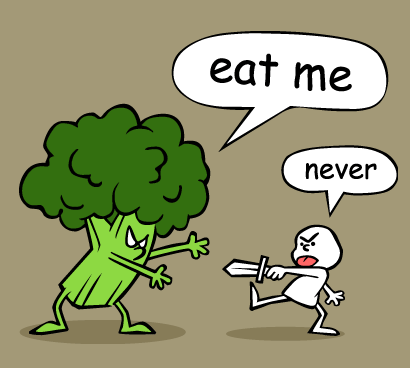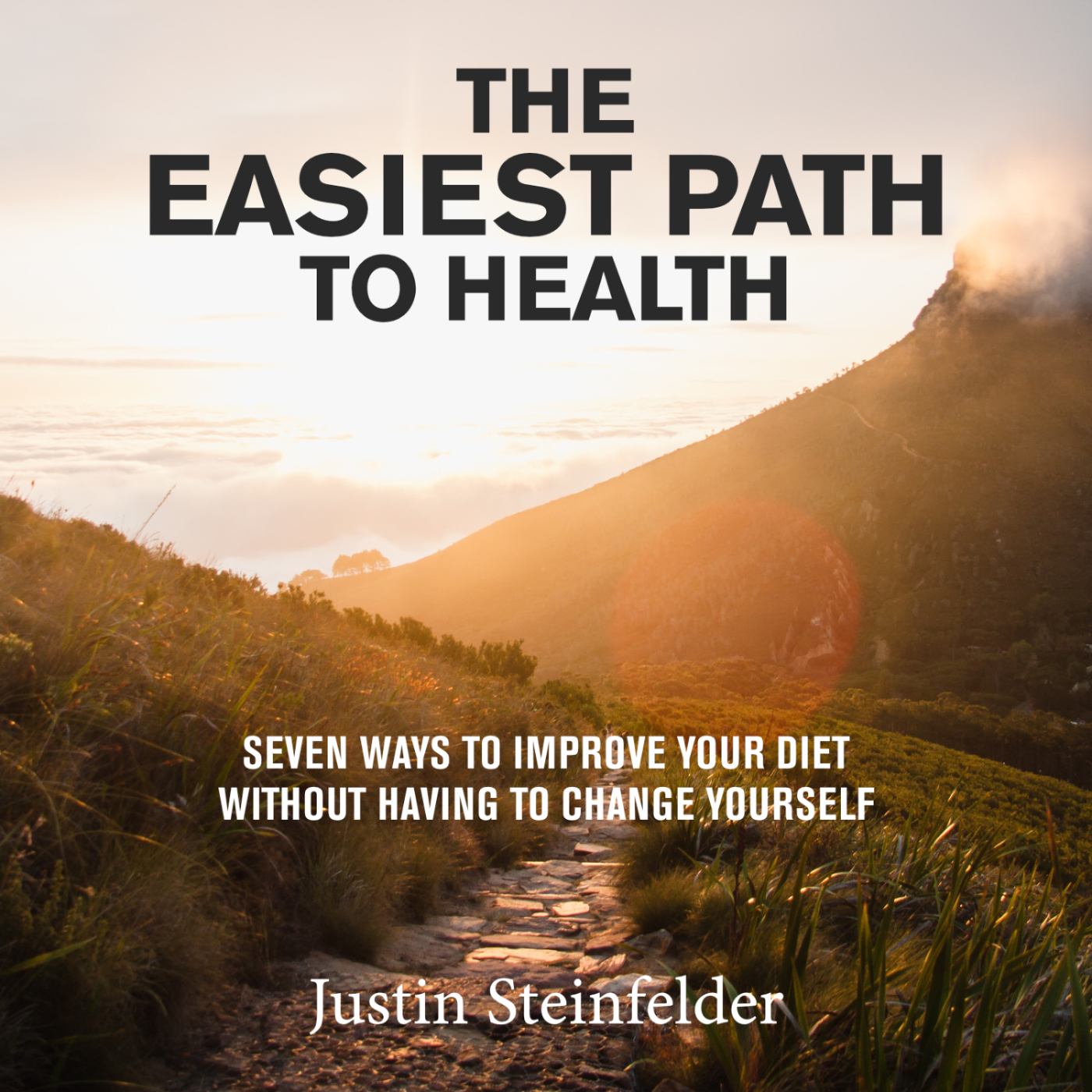[How I’d use this Article: Read the top half, then use the “Green-Light List” as a reference guide. There’s a lot of info in there.]
In my inaugural “Intelligent Eater” post, I broadly laid out the formula by which I will proceed. I told you about where I believe the biggest problems lie and my method of approaching them. If you haven’t’ read this article, don’t worry, I get it, you’re soo busy with your fancy desk, kids and responsibility. So – I am going to summarize it in five bullet-points:
- We all have some notion that we want to be healthy, but we are frustrated due to an abundance of conflicting information from so-called experts.
- Some experts claim to “know” a “truth” that is much less clear in the research than they are making it out to be (not necessarily intentionally)
- These claims serve to confuse and frustrate, making us believe there is no consensus
- There is a significant amount of researcher consensus regarding what is healthy.
- I take the Traffic Light / Venn Diagram approach: Divide the food groups into the consensus good foods (green light), the consensus bad foods (red light) and the areas of disagreement (yellow light.). From here, simply tend towards green, away from red and cautiously approach the yellow.
I ended that post with the promise that I would fill in this traffic-light Venn Diagram, detailing each light with the associated foods as the Researchers (people in lab coats) seem to have indicated. Here she is…
This article will identify the green-light foods. Usefully, the green light is the bottom, or the foundation, of the traffic light.
“Foundational” is a very useful way to think about green-light foods, or perhaps even more apt, its descendant, “fundamental.” As the very wise and oft beat-up, “Wedge,” once told Chris “Kid” Reid: “Eating is Fundamental.” (Or was that “reading?”)
was that “reading?”)
Eating is Fundamental
The first thing that you may notice about the below foods is that – well, they’re boring. They are not going to shock you or overly please you. For all of you hoping that I somehow list pizza or pho on here – it ain’t gonna happen.
But that’s just the point. The green light foods are the basics. “Base-ic” – as in, these should make up the broad base of your everyday eating. They are the things you can eat without limit; without worry of carb, protein, fat or calorie. They are the only “light” where more is typically better.
Just like learning any new skill, behavior, or mindset, at first, it might be a bit of a struggle. Similar to learning the rules of grammar or the G-chord on a guitar or getting low and shuffling your feet or, god forbid, accounting skills.
But these foundational skills are the most important not to get wrong, and it is on them, and only on them, that we can build a strong house (corny, but true). As Sal Kahn, the founder of Khan Academy, pointed out in this TED talk: it is absolutely absurd to move on to anything else before mastering the basics.
We all know that 6’8 guy in the gym (fellow Hebrews, insert heights approximately half a foot smaller). A full head taller and 30 pounds heavier than every other person on the court, he could dominate the paint with sound fundamentals.
 But instead, he insists that he has “mad skills” and a “soft touch” and proceeds to chuck 30-footers like he’s Eddie House while shouting out things like, “RAIN DROPS!.” This is nearly always disastrous.
But instead, he insists that he has “mad skills” and a “soft touch” and proceeds to chuck 30-footers like he’s Eddie House while shouting out things like, “RAIN DROPS!.” This is nearly always disastrous.
In his book, and in this great interview with Tony Robbins, 10-time championship coach, John Wooden attributes all his success to superior conditioning and fundamentals. In his book, The Score Takes Care of Itself, hall of fame NFL coach, Bill Walsh discusses their increased importance in times of duress:
“In the midst of the extreme pressure I placed a premium on fundamentals, the skills and the execution ability the team already possessed.”
So the next time your chubby friend tells you about his next body-hacking formula of cayenne-infused, -garlic-finished, apple-cider kombucha, tell him what Budd Kilmer gently suggested to The Mox (the damn dumbest smart kid he knows): “stick to the basics, stick to the basics, stick to the basics.”
But beyond just being fundamental to our health, longevity and diet, there are other reasons I am starting with the green-light foods. These reasons are rooted in our biology and psychology and, according to research, they nearly demand we start by adding good rather than the usual approach of restricting bad.
So before I get to our list, I want to briefly discuss each of these concepts: (1) Loss Aversion, (2) The Scarcity Principle and (3) How We Develop Good Habits.
[Again, feel free to thumb down to “The Green Light List” if you have no patience, intellectual interest, and don’t care about me seriously disliking you.]Why I Am NOT Starting With Red-Light Foods: “Loss Aversion” and “Scarcity”
Loss Aversion
Let’s say you are making $100,000 per year. I tell you today we are going to play a little game: I am going to flip a coin, heads you win, tails you lose. If you lose, I take $10,000 from your annual salary.
Question: How much money would you have to stand to win on heads to play this game?
Answer: At least $20,000.
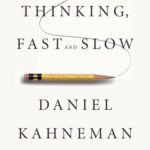 At least that is what the research of the foremost authorities on behavioral economics, Daniel Kahnenman and the late, Amos Tversky, have told us. In his book, Thinking Fast and Slow, Kahnenman tells us that we don’t like to lose things – a concept called “Loss Aversion” – even if our fear of loss does not match up with rationality.
At least that is what the research of the foremost authorities on behavioral economics, Daniel Kahnenman and the late, Amos Tversky, have told us. In his book, Thinking Fast and Slow, Kahnenman tells us that we don’t like to lose things – a concept called “Loss Aversion” – even if our fear of loss does not match up with rationality.
The explanation for this little chink in our, “oh so reasonable,” human armor, seems to have evolutionary backing. Here is how psychologist Jon Haidt puts it speaking about a similar concept called “Negativity Bias” [from The Happiness Hypothesis]:
“If you were designing the mind of a fish, would you have it respond as strongly to opportunities as to threats? No way. The cost of missing a cue that signals food is low; odds are that there are other fish in the sea, and one mistake won’t lead to starvation. The cost of missing the sign of a nearby predator, however, can be catastrophic.”
Haidt summarizes: “losses loom larger than gains.”
In other words, the last thing we want to do is lose those precious salsbury steaks or pumpkin pies (God, I love  pumpkin pie). We’d rather just add in some greens and broccoli on the side.
pumpkin pie). We’d rather just add in some greens and broccoli on the side.
Scarcity
Compliance and persuasion researcher, Robert Cialdini, is similarly instructive.
Cialdini, in his seminal book, Influence, discusses the “Scarcity Principle.” The Scarcity Principle states that we will tend to be more attracted to something we perceive to be scarce or restricted. This happens regardless of its actual utility to us and is heightened if the restriction is recent.
 Anyone who’s been, or been around, a teenager will know this well. Take something away and they instantly begin to want it much more.
Anyone who’s been, or been around, a teenager will know this well. Take something away and they instantly begin to want it much more.
But not because they value it more, but precisely because of the fact that it’s off-limits. As Cialdini explains, what they do place value in is their freedom to have it and their autonomy.
Again, the analogy to nutrition is fairly obvious. Taking cakes and pies, cakes and pies away from us is not the way to get on our good side. It turns out taking candy from a baby is not so easy… So we will start by adding, not restricting.
Breaking Bad Habits
In his book, the Power of Habit, Charles Duhigg summarizes much of what we currently know about habits. Throughout the book, Duhigg explores what habits are and why we need them.
So how do we cut out a bad habit or pick up a good one? It turns out, these are done through the same “Habit Loop.”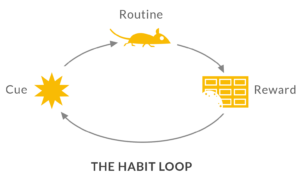
The Habit Loop is made up of three components: the cue, the routine (habit), and the reward. The cue is what signals to your body that it is time to perform the routine. The routine is the habit, lets say, smoking. The reward is the feeling that you get instantly upon performing the behavior [Duhigg summarizes in this article].
So say you’d like to kick the smoking habit and simultaneously exercise more. This intervention would take place in the same habit loop. Because as Duhigg points out: we cannot actually get rid of bad habits, we can only replace them with other habits.
That is, new, good habits are developed only by way of displacement – adding a good habit overtop of a bad one. NOT taking away the bad habit. That doesn’t work, Duhigg shows us.
Back to diet: identify the cue that leads to bad, add good instead of restricting the junk, and follow with the same reward (not the junk food itself, but the biological reward that the junk food promises such as relief from hunger). Overtime, the green will displace the junk, and surprisingly, you might grow to prefer the apple over the cookies, cakes, and, yes, even those super-good pumpkin pies.
How To Understand This List: Gaining Health and “Consensus”
Gaining Health
Eating the below food, is not merely safe. These foods are not just “OK” for you to eat without caution. These foods actively make you healthier.
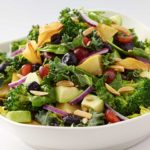 With each kale salad, each antioxidant (from, say, berries), and each bag of broccoli – you are literally (and I mean that in the literal sense, not the “shit girls say” sense) repairing your DNA – the code you are built from. You are stifling cancer, improving your heart, your mood, your brain.
With each kale salad, each antioxidant (from, say, berries), and each bag of broccoli – you are literally (and I mean that in the literal sense, not the “shit girls say” sense) repairing your DNA – the code you are built from. You are stifling cancer, improving your heart, your mood, your brain.
Let me repeat that last one: your brain. Yes, eating these green-light foods are not just an
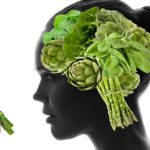
Dole.com
intelligent move because of what they can do for you blood and heart (and not to mention, waistline). They are intelligent because they may actually make you smarter.
From the Journal of Neurochemical Research:
“Accumulated evidence suggests that naturally occurring phyto-compounds, such as polyphenolic antioxidants found in fruits, vegetables, herbs and nuts, may potentially hinder neurodegeneration, and improve memory and cognitive function”
So, you know, don’t be a doofus. Eat ‘em.
“Consensus”
As I explained in this article, a green-light food is a food on which there appears to be Researcher and Public-Interfacer consensus. When I say, “consensus,” this doesn’t necessarily mean every single expert in the world agrees.
But notice, there are very little concepts in any field that have absolute 100% consensus. Take evolution for instance. In this poll, just under 40% of all US adults don’t believe in it. Yikes.
The traffic light / Venn Diagram system operates, like many things, on a sliding scale. As you move through the green, towards the yellow, there are less and less people that agree. You will see that percentage listed next to each food.
For example, a food like broccoli will have 99% consensus (just like Madden, there are no 100s), meaning most experts on earth would agree. Contrast that with Beans, which are a bit less clear given the Paleos, the Dr. Stephen Gundrys, and the Dave Aspreys of the world – more like 75%.
Oh, and by the way, these percentages are generalities. They aren’t exact, calculated figures. So do’’t bring me some equation that shows that, no, actually beans would be closer to 69.7% consensus. Spare me, La Fleur. I hate you.
Ok, now, on with the show..
The Green Light List
[After you read this list, you might find my free ebook on how to get yourself to eat all of this kale useful].As I mentioned, nothing on this list is going to shock you. What might be more interesting or shocking, however, are the foods that are omitted from this list. Foods that you possibly have eaten your whole life. That is what I would start questioning..
You might also notice that I’ve spent a bit more bandwidth on a couple foods (beans, for example) because these are foods that people might think are either clearly good or clearly controversial or bad.
Ready… ok let’s play “who wants to get tons of green shit in their teeth cause they should be eating kale and broccoli everyday..??!!!”
Greens. Dark, leafy ones.. (99%).
Unfortunately for all of us, the kale-fad is here to stay. It turns out that even though eating kale is like taking a bite out of sticker-bush, this stuff is somewhat magical. As are Spinach, Bok Choy, Mustard Greens, Collard Greens, Chard, Lettuces (yes, even iceberg to some much smaller extent).
Benefits. Form the Department of Agriculture:
“Dark green leafy vegetables are great sources of nutrition. Salad greens, kale and spinach are rich in vitamins A, C, E and K, and broccoli, bok choy and mustard are also rich in many of the B-vitamins. These vegetables also contain an abundance of carotenoids-antioxidants that protect cells and play roles in blocking the early stages of cancer. They also contain high levels of fiber, iron, magnesium, potassium and calcium. Furthermore, greens have very little carbohydrates, sodium and cholesterol.”
From the National Cancer Institute:
“Of the food groups analyzed, green leafy vegetable intake showed the strongest inverse association with major chronic disease and cardiovascular disease”
Slight Spinach Concerns:
Spinach and Kidney Stones. Raw spinach contains oxalate. Only thing you need to know is that at very high amounts and in very rare cases, it can lead to kidney stones. If you are at specific risk for kidney stone formation, perhaps get your greens from other sources.
- Way to Avoid: You can markedly reduce the oxalate content by cooking. Then again, you might not want to given oxalate’s and raw spinach’s benefits.
Buy Spinach Organic. There are certain foods more likely to be infected by pesticides or other toxins in the growing process. They are called the Dirty Dozen. Spinach is one.
- Way to Avoid: Buy Organic.
Cruciferous (Crew-Sif-Ur-Us) Veggies (99%).
Alternate Nicknames: Rod Carew-ciferous. Bro-ciferous. Taste-like-crap-ciferous. Grab-your-throat-
and-choke-thing (wait, no, that’s Major League)

Cruciferous vegetables are really 1B if the Darky, leafies are 1A. Dr. Joel Furhman talks about eating high nutritional-density, low caloric-density foods. Along with the greenies above, it don’t get no more Furman-y than this!
Just as horribly hard to swallow raw, CVs are also packed with similar nutrients that our cells need to create energy. Oh, and they are packed with something else: a little thing called cancer-fighting power.
They include: broccoli, cauliflower, brussels, bok choy, kale (you’ll notice a second appearance by the last two), cabbage.
Downside of Cooking Cruciferous. The bad news is that heat seems to deactivate the enzyme responsible for much of the cancer-fighting fortitude. And, unfortunately, it is hard to shove a raw Brussels sprout down your throat without ending up like Stu from Mrs. Doubtfire. But worry not, “help is on the way, dear.”
***A fun little chemistry experiment*** the work of Johns Hopkins, Dr. Jed Fahey, has shown that if you dump a little mustard powder on the veggies, it revives the enzyme! Magic! (Actually: science). Watch the video with Dr.  Rhonda Patrick and FoundMyFitness (probably the best nutrition podcast available).
Rhonda Patrick and FoundMyFitness (probably the best nutrition podcast available).
They also discuss the power of broccoli sprouts which have exactly a bajillion times more cancer-fighting power than regular broc.
Other Non-Starchy, non-sugary, non-nightshade-y Veggies. (95%)
You should also always eat other non-starchy, non-nightshade, non-sugary (beets) veggies such as: Artichokes, celery, cucumber, asparagus, okra, sea vegetables (arame, dulse, and nori), snap peas, radish, and zucchini (code name: zoodles.)
Nightshade..What the eff?! You might be wondering what nightshades are and what exactly qualifies as a starchy or sugary veggie? Totally reasonable. I will cover them below (i.e. ever heard of Wikipedia?!). Notice, that though they have more specific criticisms than the veggies above, they still make the green-light foods. So you should eat them, perhaps just second in priority.
Special Veggies: Garlic, ginger, Onion, Mushroom (95%)
I put these in a separate category because all of them seem to be uniquely awesome in some way and most people would say to eat as much as you can. Luckily, along with tomatoes, they also make a tasty base to cook with. Really, the only thing that makes this exclusive list not 99% is the shrooms.
Garlic: Garlic seems to be particularly good at cancer-fighting, keeping your prostate small, killing Dracula, making food smell great, and your breath smell like a toilet. It is also a great de-clotter of blood – but best raw and crushed. So throw ‘er in the old smoothie.
 Ginger: Ginger has been shown to fight inflammation, nausea, and IBS [tell Reuben Feffer: “Place didn’t sound ethnic…Al havez.”] Also lovely in tea.
Ginger: Ginger has been shown to fight inflammation, nausea, and IBS [tell Reuben Feffer: “Place didn’t sound ethnic…Al havez.”] Also lovely in tea.
- Earth to Matilda on ginger ale: it’s not good for you.
Onion: Onion seems to be similar in protection habits to its relative (in the allium family of veggies), garlic offering staunch defense against: cancer, big prostates, clotted arteries, and people you hate who have a sense of smell.
Mushroom. First, mushrooms are fungi, not plants, we get it. Second, mushroom have by far the most of an amino acid called ergothienine. It seems to be quite potent – protective of our mitochondria and DNA, and especially protective against breast cancer. However, Mushrooms are criticized for two reasons:
- I Got Mold. The Bulletproof Diet and a few others recommend avoiding mushrooms due to apparent mold and fear of inflammatory effect. But it seems from the research that they are anti-infalmmatory…
- Don’t Eat Raw. You should cook most mushrooms. There is concern about a toxin called agaratine that is destroyed by cooking.
Green Tea (Especially Matcha) and Hibiscus (95%)
Skinny. Tea might be protective against various cancers, cut cholesterol, decrease risk of diabetes, and protect against cognitive decline. Green and white teas are most likely better at all of these things given they are less processed.
Fun Fact: this fun little study seemed to show that cold-steeped, white tea has the most powerful antioxidant effect.
“Matcha? What the Hell is That?!” Jeez, get with the program here, bud. Matcha is a style of tea f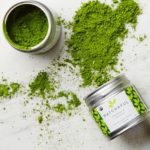 rom the Far East. It’s prepared by grinding up the green tea leaves and mixing them with water rather than steeping them in a bag. In this way, you are drinking the whole leaf instead of the less nutritious run-off.
rom the Far East. It’s prepared by grinding up the green tea leaves and mixing them with water rather than steeping them in a bag. In this way, you are drinking the whole leaf instead of the less nutritious run-off.
You might think of it like the difference between juicing and smoothies. We prefer smoothies because they include the entire food, but we will settle for the (vegetable) juice if we have no other option. So if you can’t get to matcha, just grab a green-tea. [The best brand of Matcha I’ve seen is Matchaful – so ask for it in your local coffee shop. I have no financial affiliation].
Hibiscus. Hibiscus tea, in a recent study, was shown to beat out all other teas (and 3000 other foods and bevs) in a measure of antioxidant power. Antioxidants are the things that prevent little molecules in your cells from “oxidizing.” To understand why this is good, cut open an apple and leave it there for a few minutes. The browning is oxidation. You don’t want that happening to your cells.
Hibiscus carries another advantage in terms of health – it is caffeine free. Caffeine is not necessarily all bad, but there is at least some controversy over it, so this just allows us to escape that.
Other Teas and Coffee. The different teas – green, black, white, red, etc – are measures of how much the tea leaf has been aged or roasted. Less roasted (green and white) equals less caffeine and perhaps more nutritional value. Black tea, given more caffeine and less nutrition is lower down this list.
This applies similarly to coffee which has at least double the caffeine of black tea and triple that of green. I talk about them below.
Nightshades (90%) (Nickname: M Night-Shade-alans)
The Skinny. Nightshades are a family of veggies including potato, tomato, bell pepper and eggplant. Most people don’t see an issue here. But some do, including Tom Brady as he mentions in his memoir-wrapped sales-pitch, The TB12 Method.  But, here’s the thing about Tom Terrific: he’s a dweeb. Jk, lol, brb.
But, here’s the thing about Tom Terrific: he’s a dweeb. Jk, lol, brb.
Benefits. Great sources of antioxidants and have been (especially bell peppers) inversely associated with Parkinson’s Disease.
Tomatoes: tomatoes have a very powerful antioxidant called lycopene (10x more powerful than Vitamin E) that has been associated with lower rates of heart disease, cancer, and even depression – you’re gonna wanna get you some’a that.
- Note 1: **Cook or Eat With Fat ** – If you cook tomatoes, the lycopene content is increased by over 150%. Lycopene is also fat-soluble, so eating with (green-light) fats will increase absorbtion.
- Note 2: this is not an invitation to eat tomatoes and cheese. I don’t care how “fresh” the “moo-tz-a-rell” is.
 More Like Night-mares? The Plant-Paradox man, Dr. Steve Gundry, who is apparently now Tony Robbins’s boy, is particularly against this family as they have these mysterious lectins. Additionally, as I said, Brady is “careful” with tomatoes and eggplant due to apparent inflammatory tendencies. [This is strange however given a review of existing data suggests the anti-inflammatory effects of tomatoes.]
More Like Night-mares? The Plant-Paradox man, Dr. Steve Gundry, who is apparently now Tony Robbins’s boy, is particularly against this family as they have these mysterious lectins. Additionally, as I said, Brady is “careful” with tomatoes and eggplant due to apparent inflammatory tendencies. [This is strange however given a review of existing data suggests the anti-inflammatory effects of tomatoes.]
Note on Lectins: While Gundry, Asprey and a few others seem to be convinced of the inflammatory capabilities of lectins, most of the research that I’ve seen suggests that most of the threat is neutralized by cooking or possibly non-existent. However, this is still a real concern to me as these are not dumb guys (and neither are there many big-name supporters). I wouldn’t assume without more data that they are either(a) divisive (trying to sell products) (b) crazy or (c) wrong.
Apple Cider Vinegar (& other vinegars) 85%.
The gist: Although ACV is nauseatingly popular as a get-healthy-quick scheme, we shouldn’t dismiss it altogether. A tablespoon or two of apple cider vinegar, and most other vinegars for that matter, are probably good for your health. There are a couple downsides, but they mostly surround overconsumption.
Benefits. ACV has been shown to blunt blood sugar, kill off ‘bad bacteria,’ and may lower your appetite. Plus, given that it is fermented apples, it is full of the B vitamins (other vinegars have other fruit properties. Many of the same nutrients in grapes are also in balsamic or red wine vinegar).
Downsides. ACV and other vinegars are acidic. Acid has been shown to have various impacts on the body from overloading the kidneys to destroying tooth enamel. Additionally, some of the weight-loss trials suggest that people were merely less hungry b/c the ACV promoted nausea and decreased food absorption.
Overall. Annoying as it is, many of the influencer-type ACV proponents are on the right track. But, as always, they’ve blown this thing way out of proportion. Add a couple dashes of vinegar to your salad daily, and you should get the Ups without the Downs.
If you’re interested in making your own ACV, check out this great article by my friend, Joan Clark, on how to make homemade vinegar.
Avocado, Lemon, Lime. 85%.
The Gist. These are mostly good. Some people are categorically against fruit due to sugar. Some are worried about the cals. Some people are so douchey as to remind you how smart they are by informing you, eagerly, that the avocado is a fruit. I usually respond by taking the pit out and throwing it at one of their knee-caps.
A Note On “Shit Girls Say“: Like apple cider vinegar, perhaps the biggest problem with avocados is simply how much upper-middle-class white-girls have taken to them. “OMG I love avocados.” Their dating-app profile then reads: “Requirements: tall, dark, handsome, must love dogs and avocados!”
white-girls have taken to them. “OMG I love avocados.” Their dating-app profile then reads: “Requirements: tall, dark, handsome, must love dogs and avocados!”
Benefits: Avocado is certainly becoming very popular but it seems, for once, (as King Priam says to Helen) the gossips were right. For one thing it is high in something called phytosterol which is thought to be both cancer and cholesterol-fighting. Second, although high fat (about 30g) they are a mostly monounsaturated fat (including oleic acid) which might be good news. Fat helps to absorb other important minerals and vitamins, but unlike other fats like oils, this one seems to come with an entire alphabet of vitamins as well as that ever-elusive, fiber.  They also make a good face-mask.
They also make a good face-mask.
As for lemons and limes – citrus seems to increase blood flow and reduce risk of stroke according to this study. Ferriss (in 4HB) claims lemon acts to blunt insulin spike.
Detractors: For lemon and lime it might be the sugar content (something I’ll address in the berries section) and for ‘Cados it would be the fat / calorie content. If you are on a diet where this is a concern, sure, don’t eat 10 avocados per day at 150 cals / 30 gs of fat a pop…doyyy
Seeds and Nuts (85%)
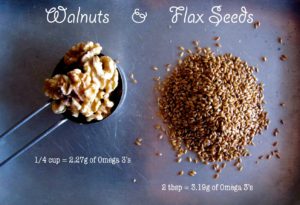
Skinny. Some warn against the calories / fat. Some think peanuts (yes, we know, we know) are inflammatory and cashews have lectins. Having said that, nuts and seeds have been associated in multiple, multiple studies with lower incidences of heart disease and stroke, and longer lifespans.
Is it because they displace other less healthy foods? That’s perhaps some of it. But, here’s the thing, that actually matters too. If they blunt your hunger or are even neutral, perhaps you will eat less cheetos and Captain Crunch Berries.
Special Seed: Flax. Flax is nearly 100% approval. However, eat it ground up otherwise it doesn’t seem to be digested. The “linigans” in flax seem to protect against cancer. They are also a good source of the plant-based omega-3 – ALA. This seems to contribute to improved arterial function.
Special nut: Walnut. Walnuts seem to have the greatest amount of antioxidants and ALA of the nut kingdom. They also may play roles in cancer prevention and seem to have the least lectin scare. Lastly, they seem to counter that feared source of all that is evil: inflammation (while fish did not prove to be protective).
Detractors: most of them are afraid of the calories. Some are afraid of the lectins. The calories might be a concern, although, consider this study. Most of all, people like to point out that peanuts are not nuts, they are legumes. The person than proceeds to bow and awaits applause. I usually throw a tomato (fruit) as his face, pelt a coffee bean (fruit) at his left eye, and then hit him on the head with a tack-hammer made of corn-ear (grain). If he’s driving, I throw a banana (berry) peel in front of his Mario-kart.
Berries (80%)
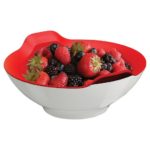
Skinny. Perhaps second to only the fruit-imposters like avocado and tomato, berries are a fruit that typically get a free pass given their low glycemic index, category-leading amount of antioxidants and general awesomeness. Berries are apparently cancer-fighting as well.
Detractors: mostly has to do with the crowd interested in being “swoll.” They claim that even berries have lots of the sugar, fructose, and they are worried about its consumption with respect to love-handles and liver function. In light of all the research, this view makes me feel like i’m taking crazy (fructose) pills.
Berries / fruit have been shown to lower, not raise, blood sugar response, even when consumed with other high sugar foods!. In this cray cray study, about 20 people were told to eat 20 servings per fruit a day and had zero negative effect on body weight, blood pressure or insulin!
Tim Ferriss also is concerned about how fructose (the sugar in fruit) is processed in the liver. This might be a concern of non-fruit fructose, but not, it doesn’t seem, from whole fruit according to this study.
- Note: I believe when Tim tested fruit in the 4HB – he used pulp-free orange juice. Come on, Tim. Get real. Also, enough with the “Fruck-Tose” pronunciation, bra. That’s as cool as pronouncing amateur: “Am-eh-TOR” Love ya!
Herbs and Spices (80%)
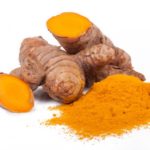
Skinny. Herbs and spices are plant-derived flavor-makers. Many of them are packed with anti-oxidants, have positive effects on blood pressure, and even seem to have cancer-fighting properties. Some of the best in the research seem to be: turmeric, ginger, oregano, fenugreek, cilantro (i.e. Soapy dirt), cayenne.
Detractors: Concerns center around that always ambiguous “inflammation” and possibly bad / stale versions of certain spices. To avoid the ladder, try and buy spices quality, or you can even grind up the herbs and roots by yourself using a coffee bean grinder or small blender and a knife. Not so hard.
Note on Turmeric. Turmeric seems to have so many benefits that Dr. Michael Greger recommends to eat it daily. You don’t need too much, merely a half-a-teaspoon per day might get you the anti-inflammatory and cancer-fighting effects.
Beans (75%).

The Skinny. Paleos, Gundry, Asprey say no. Most people seem to indicate yes, especially all of the Blue Zone people who tend to eat many beans and live the longest lives. There are also multiple studies associating beans with lower all-cause mortality, lower cancer prevalence, heart disease, etc, etc.
Benefits:
- Research. Potentially protective against cancer according to the World Research Cancer Fund who says to eat beans with every single meal. [This was the result of the most comprehensive research on diet every performed]
- Public Interfacer’s. Dr. Michael Greger in How Not to Die: “They’re loaded with protein, iron, and zinc, as you might expect from other protein sources like meat, but legumes also contain nutrients that are concentrated in the vegetable kingdom, including fiber, folate, and potassium. You get the best of both worlds with beans, all the while enjoying foods that are naturally low in saturated fat and sodium and free of cholesterol.”
Detractors.
- We didn’t eat them: Loren Cordain talks of “an earlier time when humans didn’t eat… legumes… the foods that produce chronic low-level inflammation in our bodies through a variety of physiological mechanisms.” Cordain, The Paleo Diet Revise
- Lectins: Most cite this 1999 BMJ article where sickness ensued from red kidney beans thought to be related to high lectin content.
- Less Bio–Available. The argument is that even if beans have, say, iron, the plant iron binds to other structures in beans and does not get absorbed efficiently. In this article, Cordain gets into that and a lot more “anti-nutrients.”
Why They Still Make My Cut: it appears that many of the legume issues have been answered by the research – even the fart-relates ones...
- This article by Researcher Martin Jones suggests they DID eat legumes in the Paleolithic – including its prevalence in what’s now the Middle-East.
- If you can’t access the above article – you can read this article discussing what is in it.
- Here’s the thing about that kidney bean study – the beans were not cooked properly! The abstract from this study neatly does away with concern:
- “The consumption of raw red kidney beans may lead to acute gastroenteritis, which may be severe. The toxic factor is most probably a haemagglutinin that is destroyed by adequate cooking.”
- This study shows regular methods of soaking and cooking beans (as in what would be done in any really edible bean) gets rid of most of the concerns listed.
- From the Study: “Soaking and cooking peas and beans are effective in removing or reducing anti-nutrients such as tannins, TIA and acid phytic acid”
Starchy, Sugary veggies (70%)
What Qualifies: potatoes, Sweet potatoes, yams, beets, carrots, squash
The Skinny. The claim here is similar to berries and other fruits: high glycemic effect. However, in the research that I’ve seen, this effect does not seem to occur so much with either the starchy / sugary veggies or even many of the fruits. The key is, they must be eaten whole, including the skin (e.g. sweet potato skin has 10x the antioxidants as the flesh).
Specifically, the ones I’ve listed here are packed with so much good shit that it would be hard to avoid them.
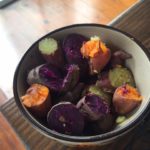 Sweet Potatoes are Fun: Potatoes are fine, colored potatoes are better, and sweet potatoes are best (Did someone say SUPERFOOD!?}. Did you know there is something called a purple sweet potato?! [See: pic of mine last week.] They are the best invention of all time. I know they love them in the Far East – best contribution just after the chopstick and the crane kick (“no can defend”).
Sweet Potatoes are Fun: Potatoes are fine, colored potatoes are better, and sweet potatoes are best (Did someone say SUPERFOOD!?}. Did you know there is something called a purple sweet potato?! [See: pic of mine last week.] They are the best invention of all time. I know they love them in the Far East – best contribution just after the chopstick and the crane kick (“no can defend”).
Beets. Because of the nitrates in beets, increasing blood flow to muscles, eating them apparently improves running performance.
Whole-Grains That Aren’t Wheat (including corn) (65%).
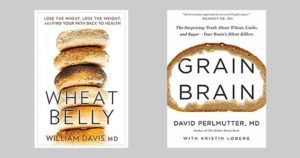
Skinny. This was a close call for me to include here v. in the yellow-light foods (note the lighter green color. yup. Smart.). Just as in the case of most nutrition research of large amounts of people over large amounts of time, the research on whole grains (as opposed to refined grains, white flour, packaged crap) is mostly associative. So, people who reported eating so and so servings of whole-grains per week also tend to live longer and have less heart disease. So how do we know it is the whole grains themselves that are good and not just other factors of people who are healthy?
A Note on Type Of Grains: we are talking whole-grains here: the entire grain, not stripped of its germ and its bran and its – hold your laughter – endosperm, and left bare and white for the rich operators of the West India Trading Company. So, everything from the “grain-brain” and “wheat-belly” crowds on sugar and refined grains does not necessarily apply here.
Argument For Good. A multitude of associative and epidemiological studies have linked whole-grain consumption with better, well, nearly everything. The response is generally, yes, but how do we know it isn’t just that people who tend to eat whole-grains, tend to be healthier, i.e. more active, eat more veggies. That makes sense, but then again, this study showed the benefit after controlling for dietary and lifestyle factors…And then this study, a randomized, double-blind, placebo-controlled study showed distinct benefits of oatmeal.
Detractors. The main discredit comes not just from the body-fat-fearing gurus, but also the inflammation and brain crowd (usually similar crowd). These are real concerns. They center around us not eating many grains until the “Agricultural Revolution” 10,000 years ago, and that if we did, they were much different species than today. The (apparent) inflammation this causes in our body and brains is the heart of disease. But, then again, there’s this study (and many others like it) showing a decrease in inflammation factors.
Note on corn. Corn has (a) insoluble fiber, the increase of which may help prevent stroke and clean out your colon (the whole “nondigestible” part of corn, therefore, is good) and (b) much more of the cartenoid, zeaxanthin, than an egg. Let’s not confuse corn with corn oil or high-fructose corn syrup which are horrible.
 Note on Gluten. [Insert basic girl voice] “Hi, I’m sorry, but I’m Gluten-free.. Is this gluten-free..Do you guys, like, have gluten free pizza?! I love avocado!!“. Ok, Ok, shut up already – I’ll address it in the forthcoming “Yellow Light Foods” article.
Note on Gluten. [Insert basic girl voice] “Hi, I’m sorry, but I’m Gluten-free.. Is this gluten-free..Do you guys, like, have gluten free pizza?! I love avocado!!“. Ok, Ok, shut up already – I’ll address it in the forthcoming “Yellow Light Foods” article.
Black Tea and Coffee (65%)
The Good. Tea and coffee have unique antioxidants called polyphenols. There have been protective effects shown, even neurologically. Coffee also seems to be protective against liver disease.
The Possibly Bad. The challenge against them relates to the caffeine and it’s uncertain overall impact on the body. The other challenge is that black coffee and black tea just don’t seem to have all the benefits of green tea or hibiscus, so that drinkinthem comes at the opportunity cost of better options.
What I do: For me, this means, most of the time, go with the least caffeine for the best teas. Those turn out to be green, white and hibiscus tea (caffeine free). Specifically for green, go with Matcha tea as it is just the green tea leaves ground up, and so you get more of the positive impact.
However, I love coffee (albeit I am a caffeine light-weight), so I drink on the weekends for fun and for taste. I probably have about 3-5 cups per week.
THE END.
So now you know. You’ve seen all of the benefits of these foods from short-term to long-term; from boost in brain and body function to the prevention of cancer, heart disease and all-cause mortality. But, the question remains, will you do anything about it?!
Notable “Snubs”:
Meat (including fish), Oils (yes, including coconut or MCTs), Red Wine, Dark Chocolate, salt, Eggs (including egg whites), dairy (including grass fed), Whole Wheat, Cinnamon. Find out why they don’t make the cut in my next two posts: Red Light Foods and Yellow Light Foods.
Still reading? How about I take a play out of the Herd’s playbook and give you not two, but one for the road. Here’s another way to think about green-light foods:
Tyler Cower from TEDx talk on stories. In this talk, Tyler Cowen has a rule for how to prevent himself from buying into self-constructed, likely false narratives – he imagines he is getting 1% dumber each time he indulges.
I think this is a great mechanism to encourage healthy eating. Imagine your brain and your heart are getting 1% stronger and healthier each time you eat a branch of kale, a bowl of berries, or, god-willing, a purple sweet potato.
Besos,
Justin
PS. How do you get yourself to eat Green-Lights — follow the steps in my short, free ebook, The Easiest Path to Health.
